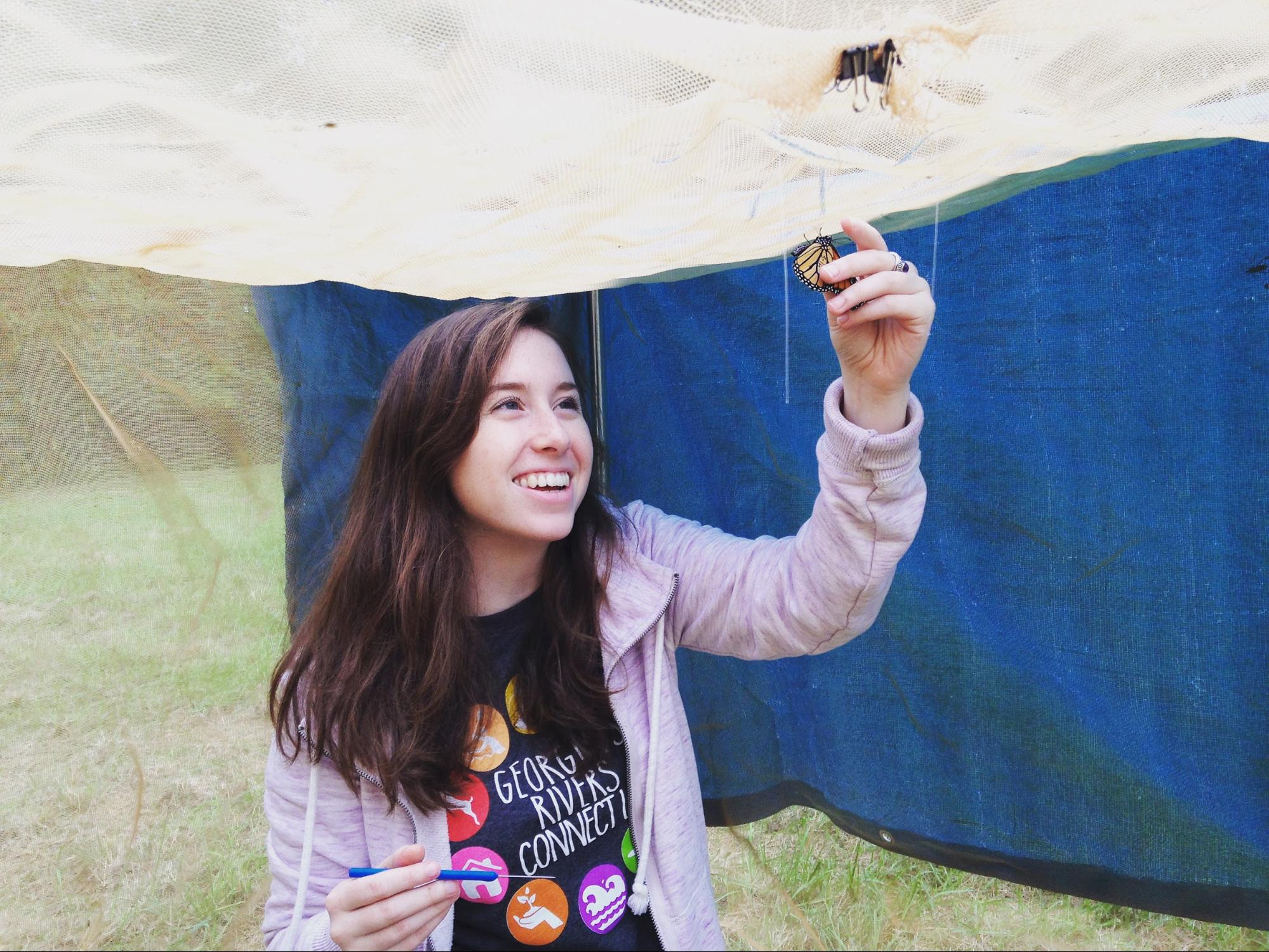Banner photo credit: Hayley Schroeder
As visitors wander through the Georgia State Botanical Garden, a flurry of life swells up to say “Welcome!†Daffodils greet you by the hundreds, insects buzz around your head and cherry blossoms come blushing into bloom. One might call this the perfect spring day…if it wasn't February. While we box up our sweaters and throw open our windows, basking in the early arrival of spring, other animals cannot adjust so easily. For monarchs, temperature is critical for surviving the winter and unpredictable weather patterns could be deadly.
Since 1994, the Monarch Butterfly Biosphere Reserve and the World Wildlife Foundation have conducted annual counts of the overwintering monarch butterfly population in Mexico. Over these 23 years, the monarch population has been on a veritable roller coaster with their numbers sometimes fluctuating by hundreds of millions from year to year. However, the overall trend is sinking lower and lower. The numbers for the winter of 2016-2017 have been released and indicate a disheartening 27% drop from the previous year, reinforcing their downward trajectory. Where do these numbers come from and what does this mean for the monarchs?

Estimating the number of monarchs overwintering in Mexico
Monarchs are a unique species to study because a large proportion of the population reliably gathers in the same place at the same time each year, providing a convenient opportunity to estimate population size. From late October to mid November, monarchs complete their fall migration and trickle into the Sierra Madre Mountains of Mexico from as far north as Canada. At nearly 2 miles above sea level, these mountains provide an ideal refuge for the monarchs throughout the winter. The temperature is maintained between 0-15° C which is warm enough to protect them from freezing but cool enough to maintain a low metabolic rate and thus conserve their precious fat reserves. The humidity also prevents desiccation while the monarchs may have little access to water during the coldest parts of winter.
When the monarchs first arrive in Mexico, they are scattered and flutter frantically around in search of the best sanctuary for the winter. As the temperatures begin to dip, they bundle tightly together on the boughs and trunks of oyamel and other pine trees in dense clusters. Tens of thousands of monarchs may cover a single tree, ceasing movement and hunkering down to outlast the winter. It is at this stage in late December, when the monarchs are the most compact, that the annual counts are conducted. In total, there are 12 colonies throughout the mountains that scientists count to evaluate the size of the overwintering population.
To estimate the number of monarchs at each site, occupied trees are mapped and the border of the colony is marked. Scientists then walk the border of the colony measuring the distance between the marked trees. The area of each colony can be calculated from this data. Based on a study conducted by William Calvert, it is estimated that there are 50 million monarchs per hectare (a hectare is 2.36 acres, essentially the size of a baseball field). This number varies based on changes in the density and size of trees occupied by the colony. Therefore, the population is typically compared from year to year based on the number of hectares of forest the colony occupies.

What were the numbers?
Last winter the overwintering monarchs surged to 4.01 hectares, a promising rise after the all time low in the winter of 2013-2014 at just 0.67 hectares. This year (the winter of 2016-2017) the monarch colonies were estimated to cover 2.91 hectares of forest. While it is normal for populations to fluctuate, these numbers indicate an overall population decline over time.
In 2015, the Pollinator Health Task Force recommended a 6-hectare overwintering population as a conservation goal in order to achieve a 50% reduction in the risk of losing the monarch migration. This is a hefty goal, and it is estimated that approximately 1.6 billion milkweed plants are needed in the landscape to support this size population. Milkweed plants, genus Asclepias, are the sole host plant for monarch larva. If milkweeds aren't present in a landscape, neither are monarchs. As astounding as this milkweed goal may be, it also means that each of us has the ability to help the monarch population in a very real way. Read more about the importance of planting native milkweed in your garden!

Why are so many monarchs needed to protect the migration?
A six hectare colony may seem like an excessive goal, however, surviving the winter is no small feat for these insects. In January of 2002, a severe winter storm hit the colonies in Sierra Chincua and Sierra del Campanario. This storm soaked the butterflies and the temperatures proceeded to drop to -4 or -5°C. The result of this single storm was devastating for the unsuspecting monarchs. An estimated 500 million butterflies were killed and came raining down from their sanctuary in the trees. Current population sizes would be less resilient to an event of this magnitude, putting the monarch migration in danger.
The ‘St. Patricks Day Storm' of 2016 killed 1.5 million monarchs and likely contributed to the decline in overwintering monarchs this year. Events like this emphasize the importance of preserving large trees in these monarch sanctuaries and highlight the fragility of this system. The trunks of the oyamel trees have a high heat capacity due to their large mass. This means that they heat and cool more slowly than their surroundings, creating a protective microclimate for the monarchs. When temperatures dip below freezing, the tree cools more slowly, keeping the monarchs warm. Conversely, when the temperature rise during the day the tree warms more slowly, keeping the monarchs cool enough to maintain a low metabolic rate and thus preserve their fat reserves.

Weather aside, monarchs also have to worry about predation by birds and mice. The scansorial black-eared mouse is the only mammal currently known to have overcome the chemical toxins that monarchs acquire by consuming milkweed plants as larva. Each year the mice migrate up to meet the monarchs and feast throughout the winter, an individual eating approximately 37 monarchs per night. In a 2.25-hectare roost, they have been estimated to consume up to a million butterflies. There are also two bird species, black-headed grosbeaks and black-backed orioles, which are able to overcome the monarchs' chemical defenses and as a group have been estimated to consume 15,000 butterflies a day.

Each day brings a new host of perils for monarchs, and each year, against all odds, they persevere. The Monarch Butterfly Biosphere Reserve ensures that the monarchs have a sanctuary to return to each winter. However, without milkweed plants across the US and Canada to support the next generation of monarchs, the population cannot possibly recover. To lose the monarch migration would be to lose one of the great wonders of the world. With each native milkweed we plant, we are one step closer to six hectares for 2018. Let's get planting!
About the author
 |
Hayley Schroeder is an undergraduate at UGA studying Ecology and Entomology. She is an enthusiastic foodie, advocating for food that nourishes not just the people eating it, but communities, farmers and the earth as well. She is also a friend to all insects and can be easily spotted on campus by her butterfly net. Contact her at hayleyadair37@uga.edu. More from Hayley Schroeder. |
About the Author
- athenssciencecafehttps://athensscienceobserver.com/author/athenssciencecafe/April 17, 2020
- athenssciencecafehttps://athensscienceobserver.com/author/athenssciencecafe/April 12, 2020
- athenssciencecafehttps://athensscienceobserver.com/author/athenssciencecafe/April 3, 2020
- athenssciencecafehttps://athensscienceobserver.com/author/athenssciencecafe/March 30, 2020







